EDUC 5397 Research: Use of Calculators in Mathematics Classrooms
VerifiedAdded on 2023/06/15
|41
|9543
|233
Case Study
AI Summary
This case study investigates the use of calculators in mathematics classrooms, particularly focusing on their impact on student learning and problem-solving skills. The research, conducted with a sample of students from a middle school in Temple, Texas, involved comparing student performance on tests with and without calculator access. The study explores both the benefits, such as increased speed and accuracy, and drawbacks, including potential over-reliance and reduced understanding of fundamental concepts. The research questions address various aspects, including the impact on time to complete tests, word count of answers, number of errors, and overall scores. The findings are presented through statistical analysis, tables, and graphs, aiming to provide educators with insights to effectively integrate calculators into mathematics education while mitigating potential negative effects. This assignment is available on Desklib, a platform offering a range of study resources for students.
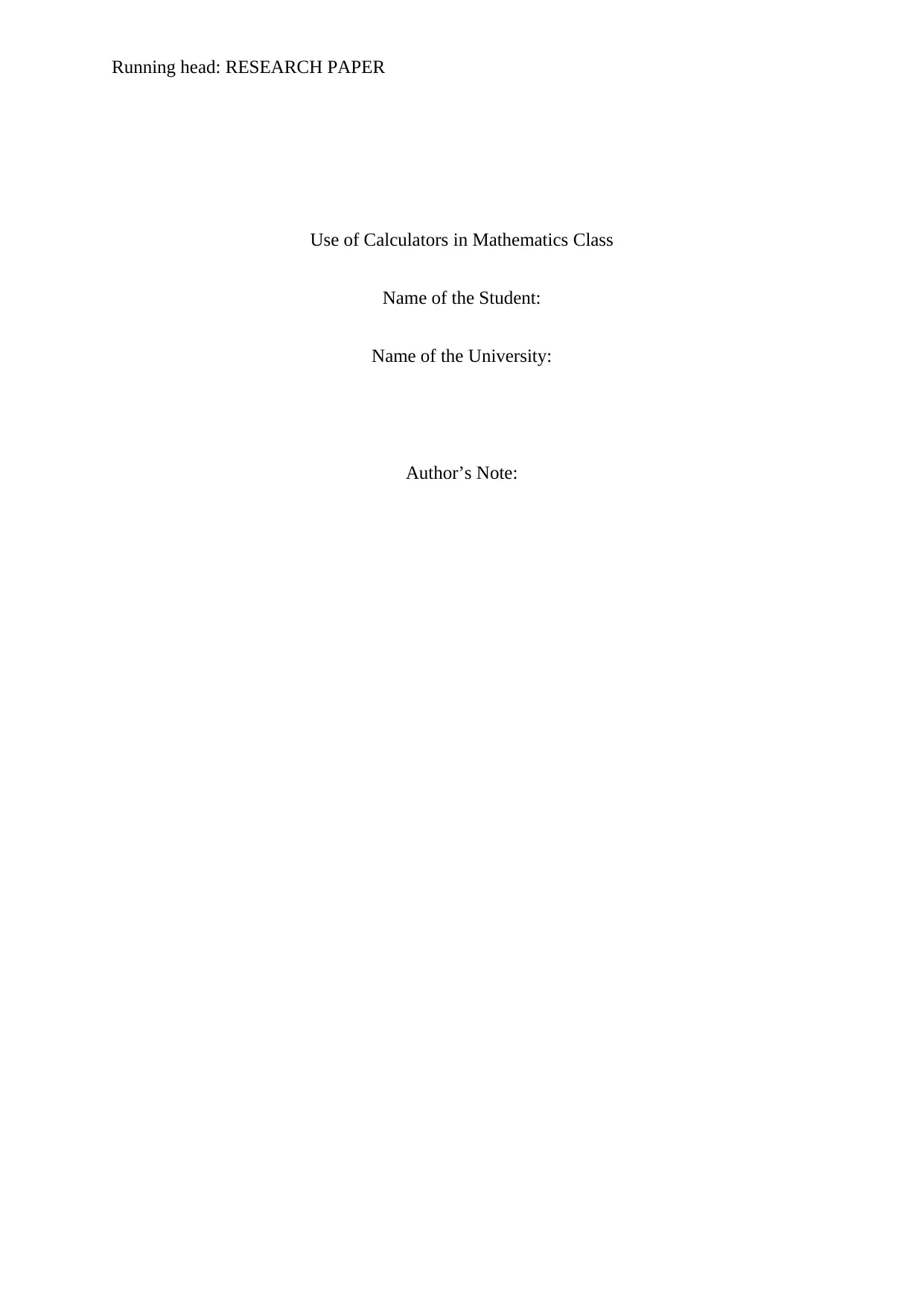
Running head: RESEARCH PAPER
Use of Calculators in Mathematics Class
Name of the Student:
Name of the University:
Author’s Note:
Use of Calculators in Mathematics Class
Name of the Student:
Name of the University:
Author’s Note:
Paraphrase This Document
Need a fresh take? Get an instant paraphrase of this document with our AI Paraphraser
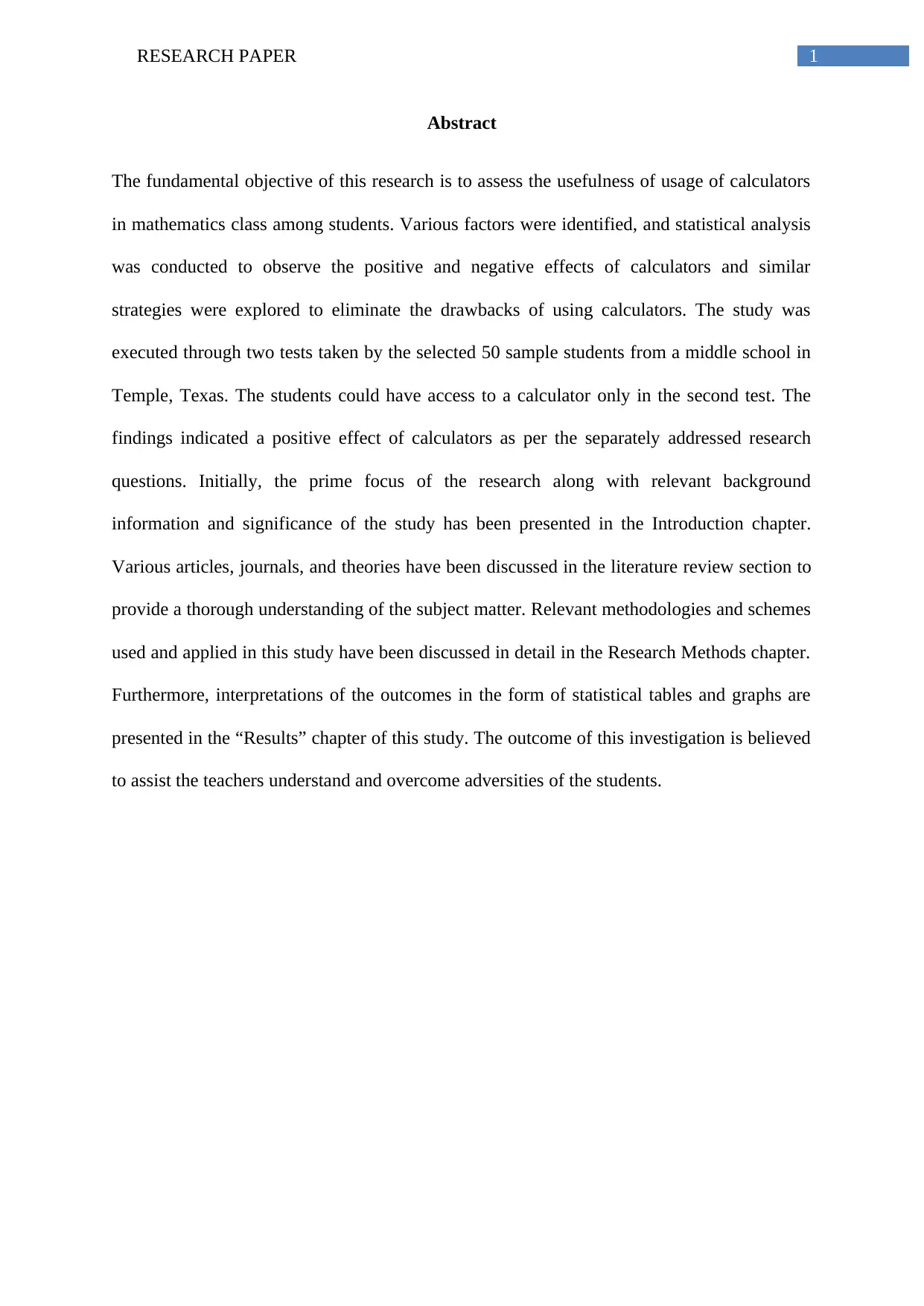
1RESEARCH PAPER
Abstract
The fundamental objective of this research is to assess the usefulness of usage of calculators
in mathematics class among students. Various factors were identified, and statistical analysis
was conducted to observe the positive and negative effects of calculators and similar
strategies were explored to eliminate the drawbacks of using calculators. The study was
executed through two tests taken by the selected 50 sample students from a middle school in
Temple, Texas. The students could have access to a calculator only in the second test. The
findings indicated a positive effect of calculators as per the separately addressed research
questions. Initially, the prime focus of the research along with relevant background
information and significance of the study has been presented in the Introduction chapter.
Various articles, journals, and theories have been discussed in the literature review section to
provide a thorough understanding of the subject matter. Relevant methodologies and schemes
used and applied in this study have been discussed in detail in the Research Methods chapter.
Furthermore, interpretations of the outcomes in the form of statistical tables and graphs are
presented in the “Results” chapter of this study. The outcome of this investigation is believed
to assist the teachers understand and overcome adversities of the students.
Abstract
The fundamental objective of this research is to assess the usefulness of usage of calculators
in mathematics class among students. Various factors were identified, and statistical analysis
was conducted to observe the positive and negative effects of calculators and similar
strategies were explored to eliminate the drawbacks of using calculators. The study was
executed through two tests taken by the selected 50 sample students from a middle school in
Temple, Texas. The students could have access to a calculator only in the second test. The
findings indicated a positive effect of calculators as per the separately addressed research
questions. Initially, the prime focus of the research along with relevant background
information and significance of the study has been presented in the Introduction chapter.
Various articles, journals, and theories have been discussed in the literature review section to
provide a thorough understanding of the subject matter. Relevant methodologies and schemes
used and applied in this study have been discussed in detail in the Research Methods chapter.
Furthermore, interpretations of the outcomes in the form of statistical tables and graphs are
presented in the “Results” chapter of this study. The outcome of this investigation is believed
to assist the teachers understand and overcome adversities of the students.
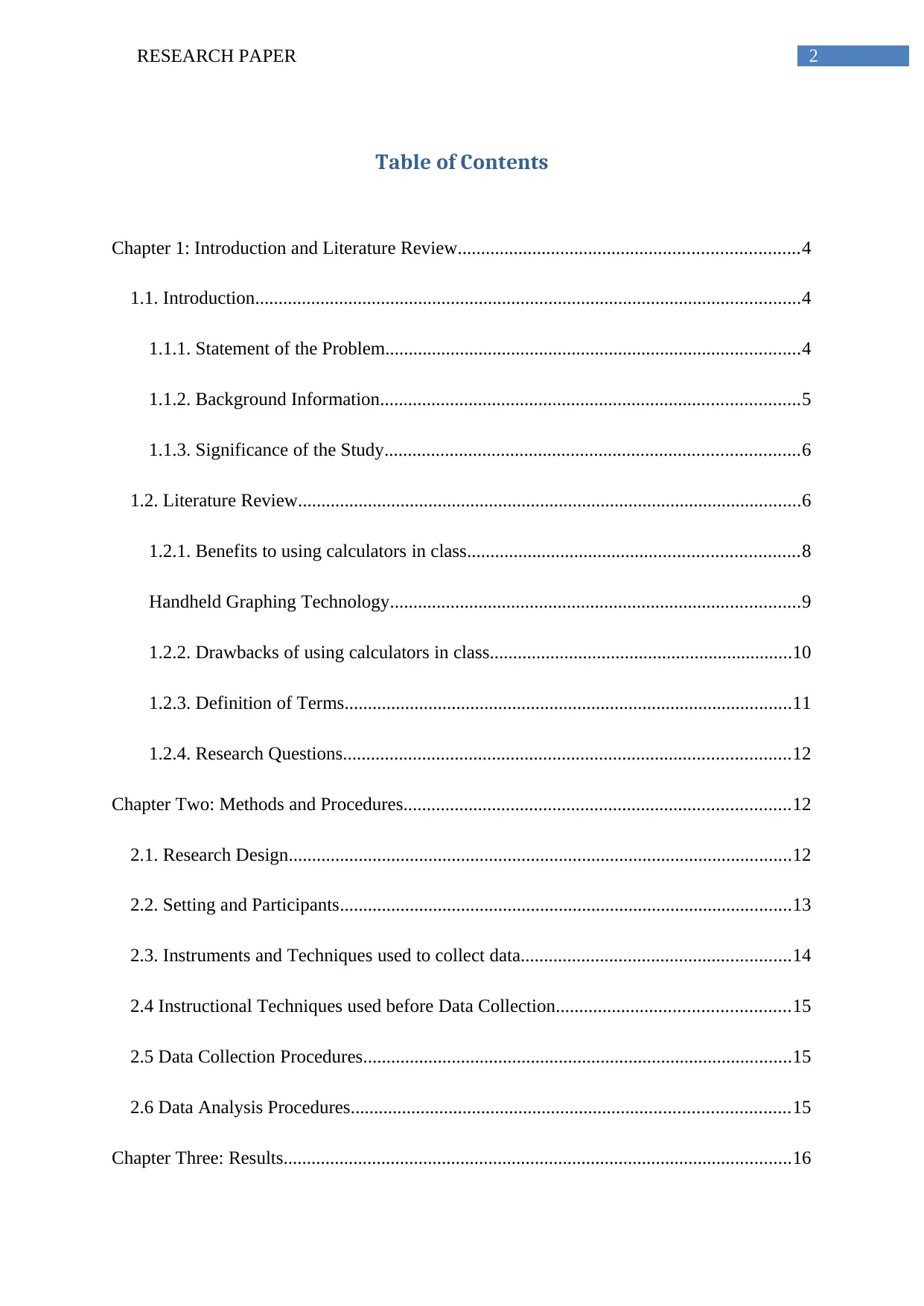
2RESEARCH PAPER
Table of Contents
Chapter 1: Introduction and Literature Review.........................................................................4
1.1. Introduction.....................................................................................................................4
1.1.1. Statement of the Problem.........................................................................................4
1.1.2. Background Information..........................................................................................5
1.1.3. Significance of the Study.........................................................................................6
1.2. Literature Review............................................................................................................6
1.2.1. Benefits to using calculators in class.......................................................................8
Handheld Graphing Technology........................................................................................9
1.2.2. Drawbacks of using calculators in class.................................................................10
1.2.3. Definition of Terms................................................................................................11
1.2.4. Research Questions................................................................................................12
Chapter Two: Methods and Procedures...................................................................................12
2.1. Research Design............................................................................................................12
2.2. Setting and Participants.................................................................................................13
2.3. Instruments and Techniques used to collect data..........................................................14
2.4 Instructional Techniques used before Data Collection..................................................15
2.5 Data Collection Procedures............................................................................................15
2.6 Data Analysis Procedures..............................................................................................15
Chapter Three: Results.............................................................................................................16
Table of Contents
Chapter 1: Introduction and Literature Review.........................................................................4
1.1. Introduction.....................................................................................................................4
1.1.1. Statement of the Problem.........................................................................................4
1.1.2. Background Information..........................................................................................5
1.1.3. Significance of the Study.........................................................................................6
1.2. Literature Review............................................................................................................6
1.2.1. Benefits to using calculators in class.......................................................................8
Handheld Graphing Technology........................................................................................9
1.2.2. Drawbacks of using calculators in class.................................................................10
1.2.3. Definition of Terms................................................................................................11
1.2.4. Research Questions................................................................................................12
Chapter Two: Methods and Procedures...................................................................................12
2.1. Research Design............................................................................................................12
2.2. Setting and Participants.................................................................................................13
2.3. Instruments and Techniques used to collect data..........................................................14
2.4 Instructional Techniques used before Data Collection..................................................15
2.5 Data Collection Procedures............................................................................................15
2.6 Data Analysis Procedures..............................................................................................15
Chapter Three: Results.............................................................................................................16
⊘ This is a preview!⊘
Do you want full access?
Subscribe today to unlock all pages.

Trusted by 1+ million students worldwide
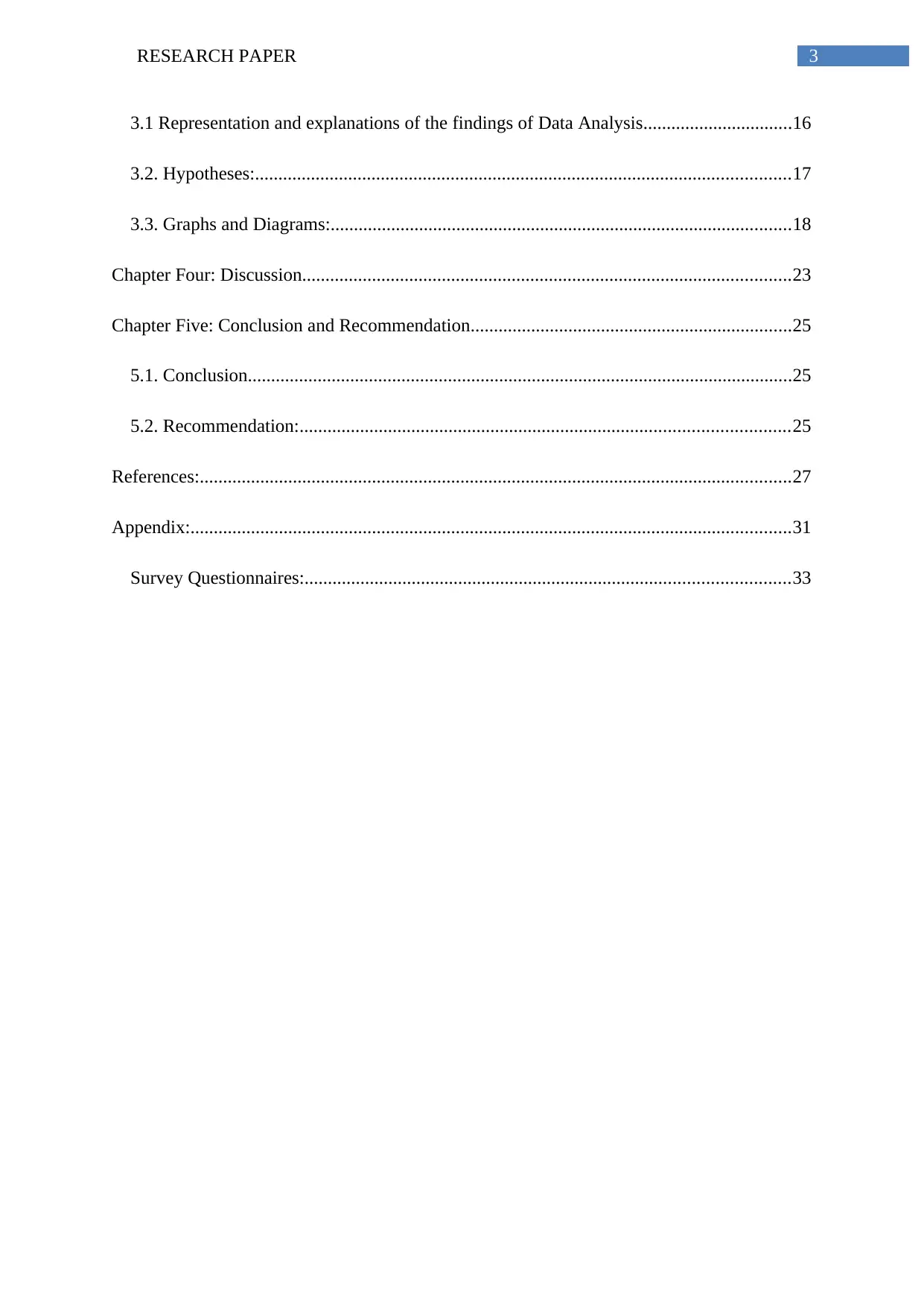
3RESEARCH PAPER
3.1 Representation and explanations of the findings of Data Analysis................................16
3.2. Hypotheses:...................................................................................................................17
3.3. Graphs and Diagrams:...................................................................................................18
Chapter Four: Discussion.........................................................................................................23
Chapter Five: Conclusion and Recommendation.....................................................................25
5.1. Conclusion.....................................................................................................................25
5.2. Recommendation:.........................................................................................................25
References:...............................................................................................................................27
Appendix:.................................................................................................................................31
Survey Questionnaires:........................................................................................................33
3.1 Representation and explanations of the findings of Data Analysis................................16
3.2. Hypotheses:...................................................................................................................17
3.3. Graphs and Diagrams:...................................................................................................18
Chapter Four: Discussion.........................................................................................................23
Chapter Five: Conclusion and Recommendation.....................................................................25
5.1. Conclusion.....................................................................................................................25
5.2. Recommendation:.........................................................................................................25
References:...............................................................................................................................27
Appendix:.................................................................................................................................31
Survey Questionnaires:........................................................................................................33
Paraphrase This Document
Need a fresh take? Get an instant paraphrase of this document with our AI Paraphraser
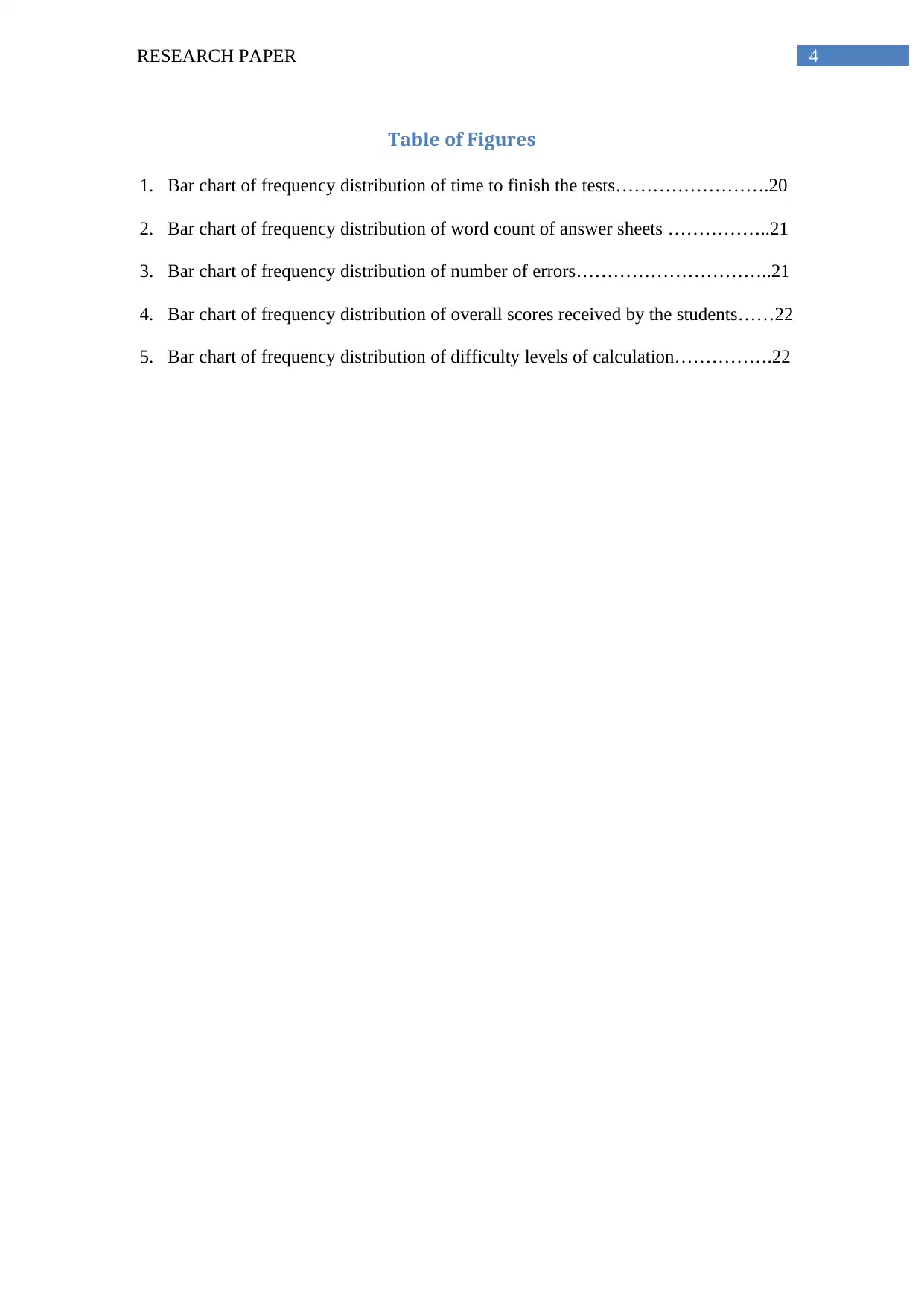
4RESEARCH PAPER
Table of Figures
1. Bar chart of frequency distribution of time to finish the tests…………………….20
2. Bar chart of frequency distribution of word count of answer sheets ……………..21
3. Bar chart of frequency distribution of number of errors…………………………..21
4. Bar chart of frequency distribution of overall scores received by the students……22
5. Bar chart of frequency distribution of difficulty levels of calculation…………….22
Table of Figures
1. Bar chart of frequency distribution of time to finish the tests…………………….20
2. Bar chart of frequency distribution of word count of answer sheets ……………..21
3. Bar chart of frequency distribution of number of errors…………………………..21
4. Bar chart of frequency distribution of overall scores received by the students……22
5. Bar chart of frequency distribution of difficulty levels of calculation…………….22
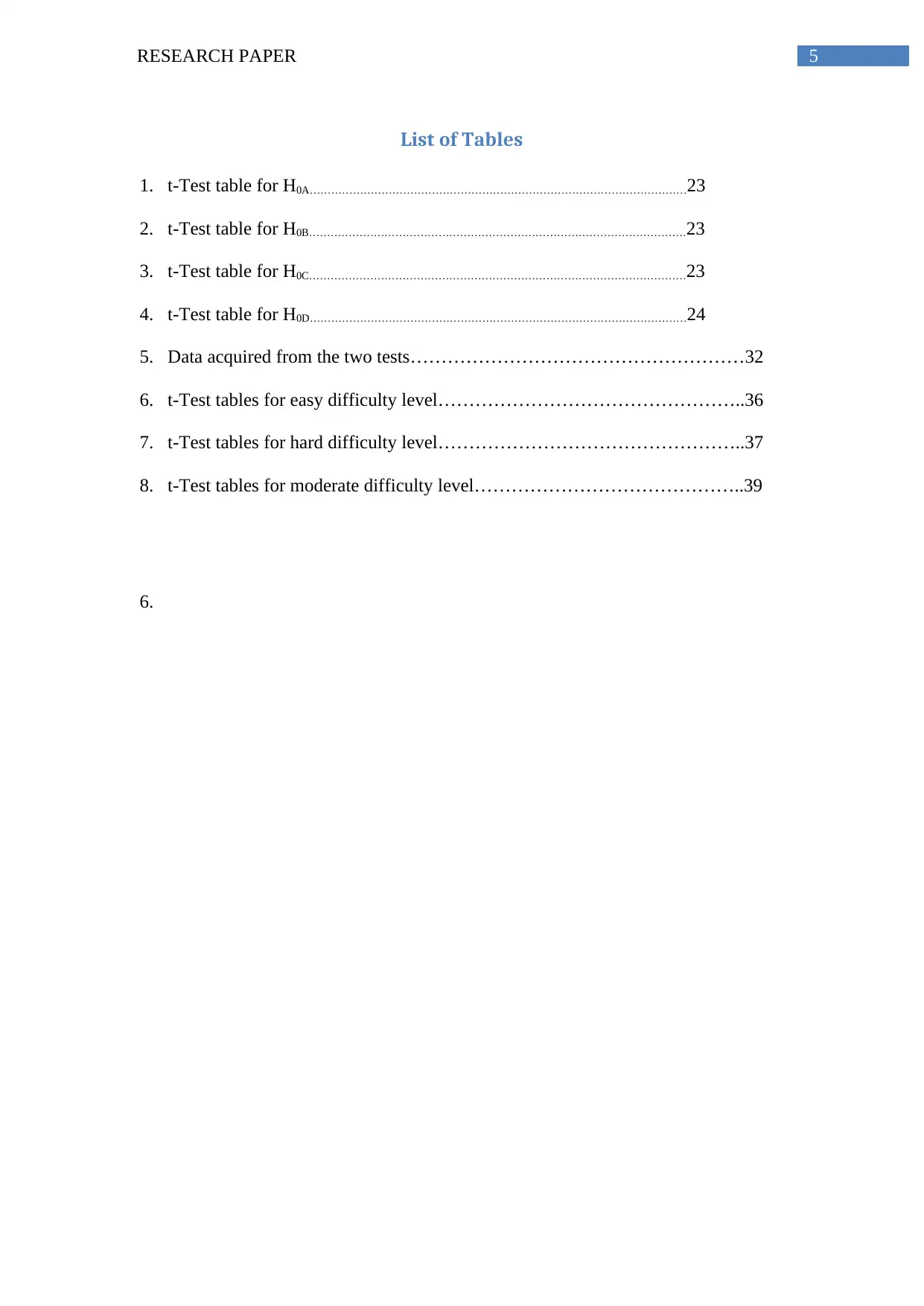
5RESEARCH PAPER
List of Tables
1. t-Test table for H0A……………………………………………………………………………………………23
2. t-Test table for H0B……………………………………………………………………………………………23
3. t-Test table for H0C……………………………………………………………………………………………23
4. t-Test table for H0D……………………………………………………………………………………………24
5. Data acquired from the two tests………………………………………………32
6. t-Test tables for easy difficulty level…………………………………………..36
7. t-Test tables for hard difficulty level…………………………………………..37
8. t-Test tables for moderate difficulty level……………………………………..39
6.
List of Tables
1. t-Test table for H0A……………………………………………………………………………………………23
2. t-Test table for H0B……………………………………………………………………………………………23
3. t-Test table for H0C……………………………………………………………………………………………23
4. t-Test table for H0D……………………………………………………………………………………………24
5. Data acquired from the two tests………………………………………………32
6. t-Test tables for easy difficulty level…………………………………………..36
7. t-Test tables for hard difficulty level…………………………………………..37
8. t-Test tables for moderate difficulty level……………………………………..39
6.
⊘ This is a preview!⊘
Do you want full access?
Subscribe today to unlock all pages.

Trusted by 1+ million students worldwide
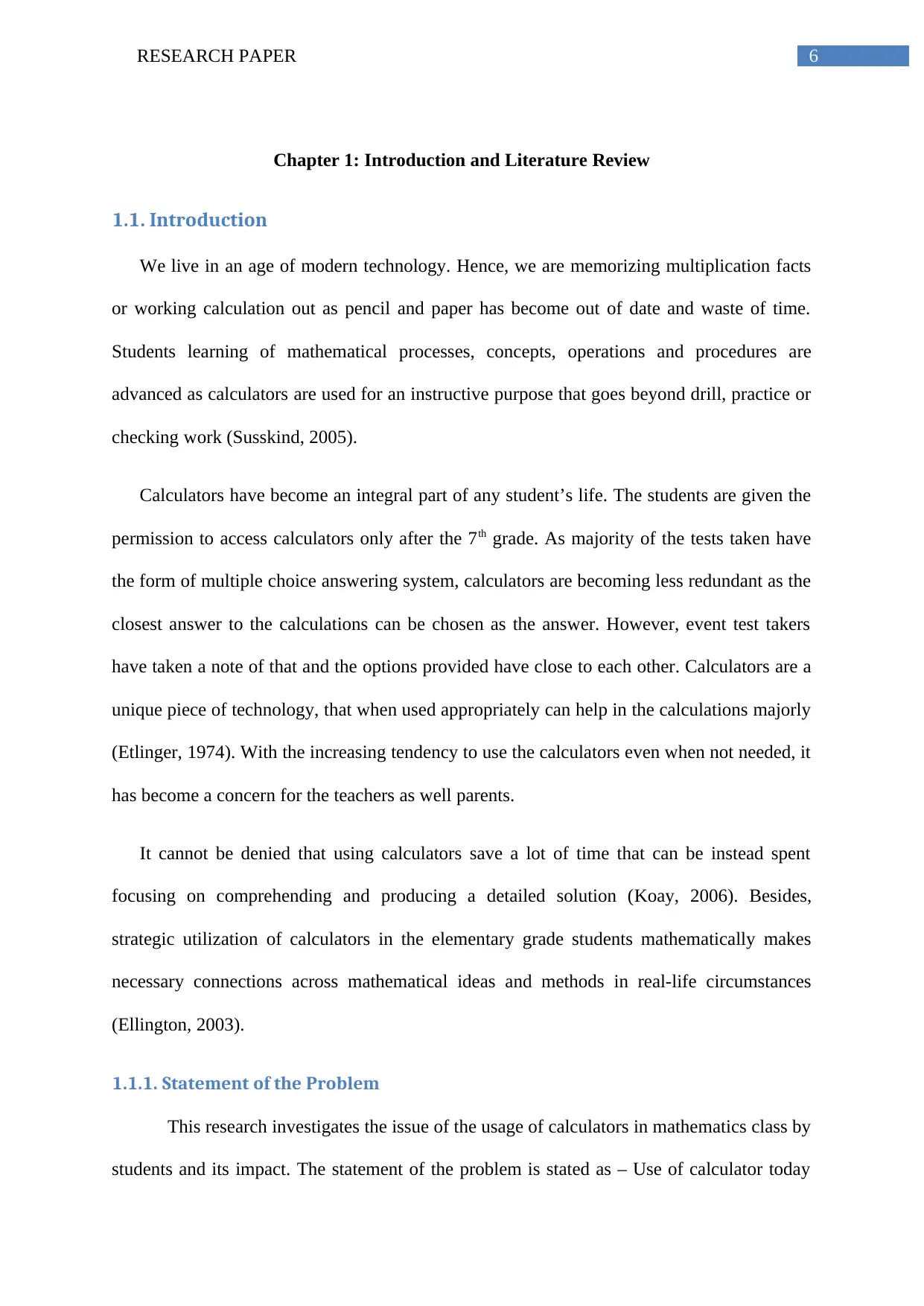
6RESEARCH PAPER
Chapter 1: Introduction and Literature Review
1.1. Introduction
We live in an age of modern technology. Hence, we are memorizing multiplication facts
or working calculation out as pencil and paper has become out of date and waste of time.
Students learning of mathematical processes, concepts, operations and procedures are
advanced as calculators are used for an instructive purpose that goes beyond drill, practice or
checking work (Susskind, 2005).
Calculators have become an integral part of any student’s life. The students are given the
permission to access calculators only after the 7th grade. As majority of the tests taken have
the form of multiple choice answering system, calculators are becoming less redundant as the
closest answer to the calculations can be chosen as the answer. However, event test takers
have taken a note of that and the options provided have close to each other. Calculators are a
unique piece of technology, that when used appropriately can help in the calculations majorly
(Etlinger, 1974). With the increasing tendency to use the calculators even when not needed, it
has become a concern for the teachers as well parents.
It cannot be denied that using calculators save a lot of time that can be instead spent
focusing on comprehending and producing a detailed solution (Koay, 2006). Besides,
strategic utilization of calculators in the elementary grade students mathematically makes
necessary connections across mathematical ideas and methods in real-life circumstances
(Ellington, 2003).
1.1.1. Statement of the Problem
This research investigates the issue of the usage of calculators in mathematics class by
students and its impact. The statement of the problem is stated as – Use of calculator today
Chapter 1: Introduction and Literature Review
1.1. Introduction
We live in an age of modern technology. Hence, we are memorizing multiplication facts
or working calculation out as pencil and paper has become out of date and waste of time.
Students learning of mathematical processes, concepts, operations and procedures are
advanced as calculators are used for an instructive purpose that goes beyond drill, practice or
checking work (Susskind, 2005).
Calculators have become an integral part of any student’s life. The students are given the
permission to access calculators only after the 7th grade. As majority of the tests taken have
the form of multiple choice answering system, calculators are becoming less redundant as the
closest answer to the calculations can be chosen as the answer. However, event test takers
have taken a note of that and the options provided have close to each other. Calculators are a
unique piece of technology, that when used appropriately can help in the calculations majorly
(Etlinger, 1974). With the increasing tendency to use the calculators even when not needed, it
has become a concern for the teachers as well parents.
It cannot be denied that using calculators save a lot of time that can be instead spent
focusing on comprehending and producing a detailed solution (Koay, 2006). Besides,
strategic utilization of calculators in the elementary grade students mathematically makes
necessary connections across mathematical ideas and methods in real-life circumstances
(Ellington, 2003).
1.1.1. Statement of the Problem
This research investigates the issue of the usage of calculators in mathematics class by
students and its impact. The statement of the problem is stated as – Use of calculator today
Paraphrase This Document
Need a fresh take? Get an instant paraphrase of this document with our AI Paraphraser
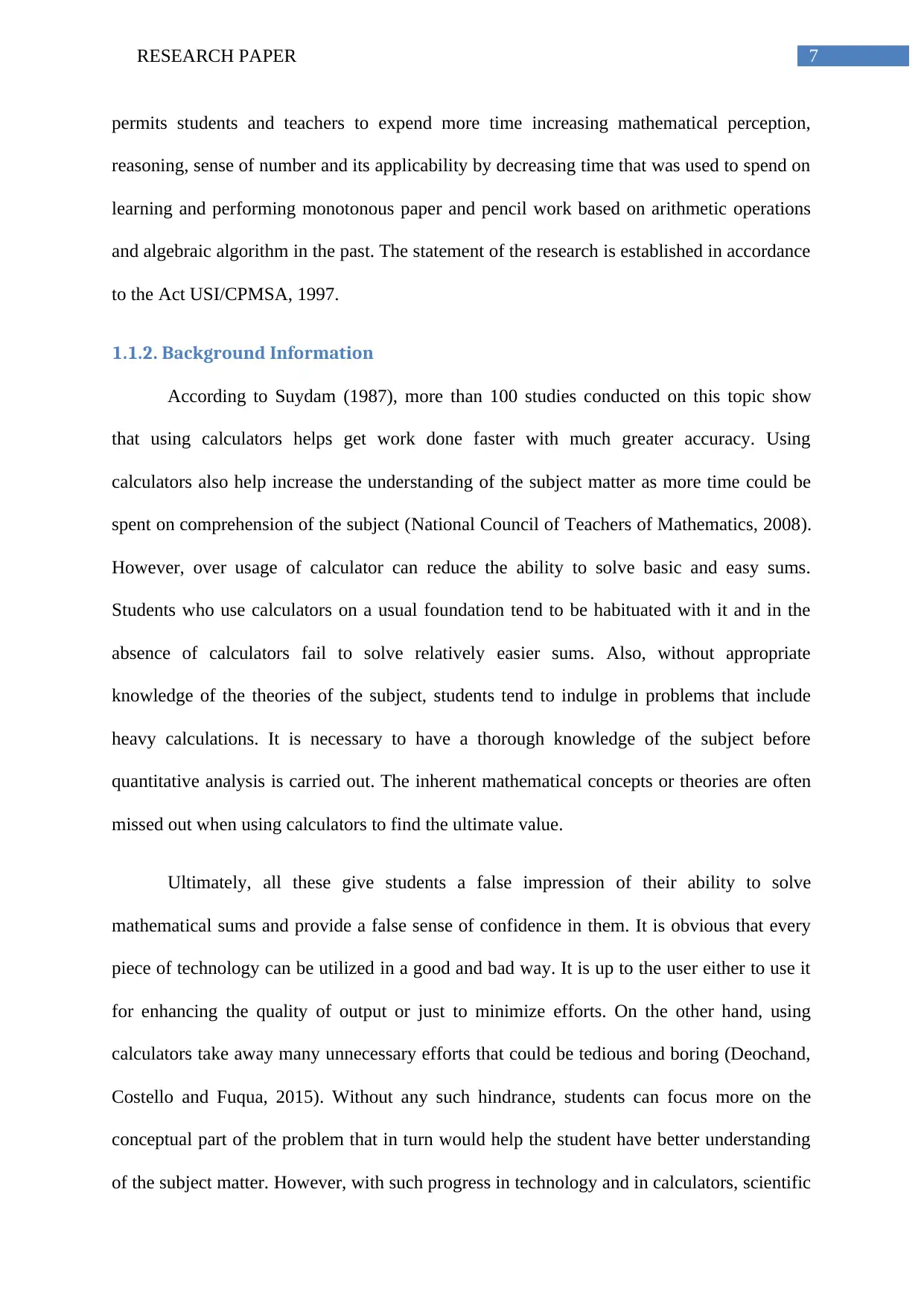
7RESEARCH PAPER
permits students and teachers to expend more time increasing mathematical perception,
reasoning, sense of number and its applicability by decreasing time that was used to spend on
learning and performing monotonous paper and pencil work based on arithmetic operations
and algebraic algorithm in the past. The statement of the research is established in accordance
to the Act USI/CPMSA, 1997.
1.1.2. Background Information
According to Suydam (1987), more than 100 studies conducted on this topic show
that using calculators helps get work done faster with much greater accuracy. Using
calculators also help increase the understanding of the subject matter as more time could be
spent on comprehension of the subject (National Council of Teachers of Mathematics, 2008).
However, over usage of calculator can reduce the ability to solve basic and easy sums.
Students who use calculators on a usual foundation tend to be habituated with it and in the
absence of calculators fail to solve relatively easier sums. Also, without appropriate
knowledge of the theories of the subject, students tend to indulge in problems that include
heavy calculations. It is necessary to have a thorough knowledge of the subject before
quantitative analysis is carried out. The inherent mathematical concepts or theories are often
missed out when using calculators to find the ultimate value.
Ultimately, all these give students a false impression of their ability to solve
mathematical sums and provide a false sense of confidence in them. It is obvious that every
piece of technology can be utilized in a good and bad way. It is up to the user either to use it
for enhancing the quality of output or just to minimize efforts. On the other hand, using
calculators take away many unnecessary efforts that could be tedious and boring (Deochand,
Costello and Fuqua, 2015). Without any such hindrance, students can focus more on the
conceptual part of the problem that in turn would help the student have better understanding
of the subject matter. However, with such progress in technology and in calculators, scientific
permits students and teachers to expend more time increasing mathematical perception,
reasoning, sense of number and its applicability by decreasing time that was used to spend on
learning and performing monotonous paper and pencil work based on arithmetic operations
and algebraic algorithm in the past. The statement of the research is established in accordance
to the Act USI/CPMSA, 1997.
1.1.2. Background Information
According to Suydam (1987), more than 100 studies conducted on this topic show
that using calculators helps get work done faster with much greater accuracy. Using
calculators also help increase the understanding of the subject matter as more time could be
spent on comprehension of the subject (National Council of Teachers of Mathematics, 2008).
However, over usage of calculator can reduce the ability to solve basic and easy sums.
Students who use calculators on a usual foundation tend to be habituated with it and in the
absence of calculators fail to solve relatively easier sums. Also, without appropriate
knowledge of the theories of the subject, students tend to indulge in problems that include
heavy calculations. It is necessary to have a thorough knowledge of the subject before
quantitative analysis is carried out. The inherent mathematical concepts or theories are often
missed out when using calculators to find the ultimate value.
Ultimately, all these give students a false impression of their ability to solve
mathematical sums and provide a false sense of confidence in them. It is obvious that every
piece of technology can be utilized in a good and bad way. It is up to the user either to use it
for enhancing the quality of output or just to minimize efforts. On the other hand, using
calculators take away many unnecessary efforts that could be tedious and boring (Deochand,
Costello and Fuqua, 2015). Without any such hindrance, students can focus more on the
conceptual part of the problem that in turn would help the student have better understanding
of the subject matter. However, with such progress in technology and in calculators, scientific
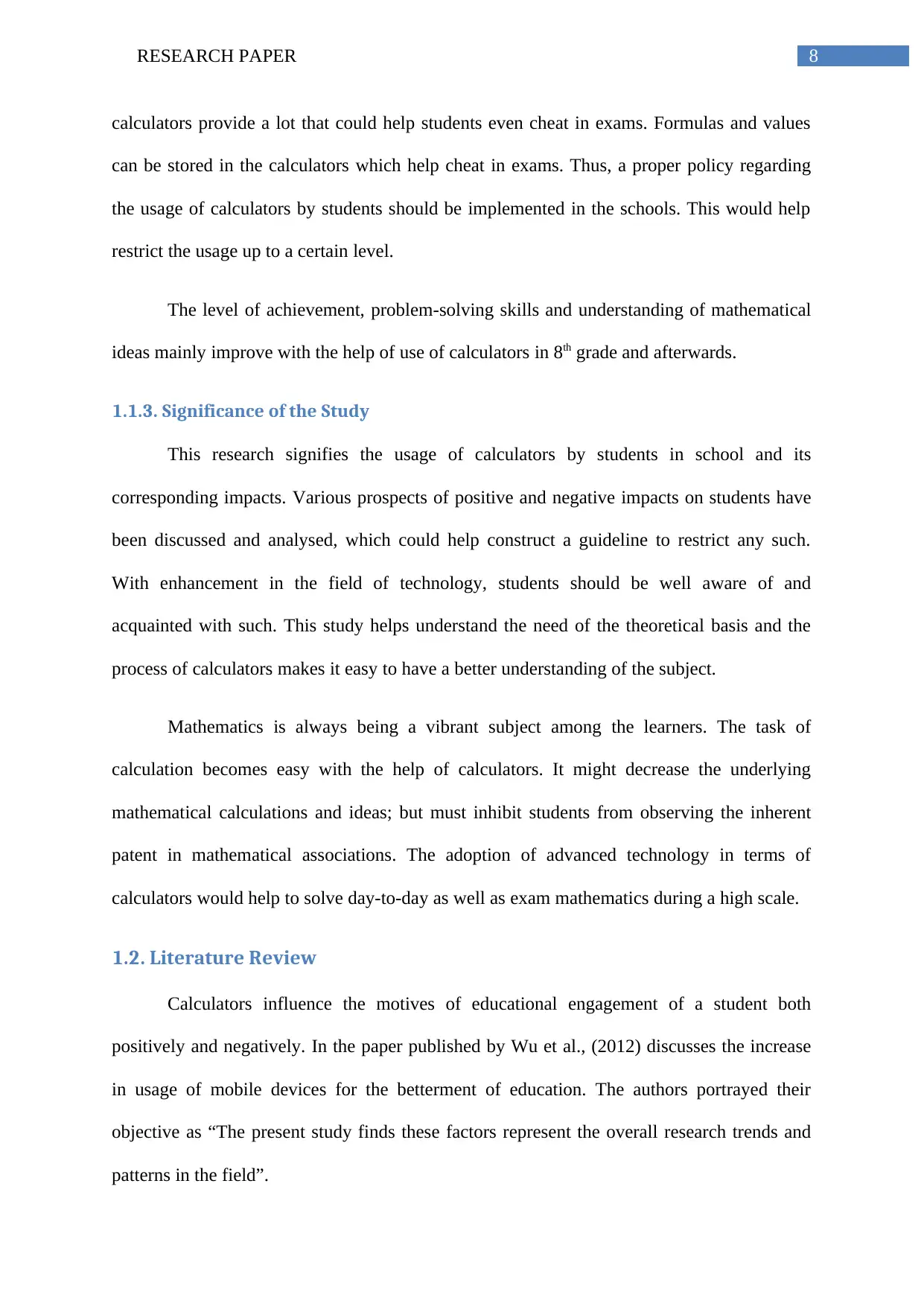
8RESEARCH PAPER
calculators provide a lot that could help students even cheat in exams. Formulas and values
can be stored in the calculators which help cheat in exams. Thus, a proper policy regarding
the usage of calculators by students should be implemented in the schools. This would help
restrict the usage up to a certain level.
The level of achievement, problem-solving skills and understanding of mathematical
ideas mainly improve with the help of use of calculators in 8th grade and afterwards.
1.1.3. Significance of the Study
This research signifies the usage of calculators by students in school and its
corresponding impacts. Various prospects of positive and negative impacts on students have
been discussed and analysed, which could help construct a guideline to restrict any such.
With enhancement in the field of technology, students should be well aware of and
acquainted with such. This study helps understand the need of the theoretical basis and the
process of calculators makes it easy to have a better understanding of the subject.
Mathematics is always being a vibrant subject among the learners. The task of
calculation becomes easy with the help of calculators. It might decrease the underlying
mathematical calculations and ideas; but must inhibit students from observing the inherent
patent in mathematical associations. The adoption of advanced technology in terms of
calculators would help to solve day-to-day as well as exam mathematics during a high scale.
1.2. Literature Review
Calculators influence the motives of educational engagement of a student both
positively and negatively. In the paper published by Wu et al., (2012) discusses the increase
in usage of mobile devices for the betterment of education. The authors portrayed their
objective as “The present study finds these factors represent the overall research trends and
patterns in the field”.
calculators provide a lot that could help students even cheat in exams. Formulas and values
can be stored in the calculators which help cheat in exams. Thus, a proper policy regarding
the usage of calculators by students should be implemented in the schools. This would help
restrict the usage up to a certain level.
The level of achievement, problem-solving skills and understanding of mathematical
ideas mainly improve with the help of use of calculators in 8th grade and afterwards.
1.1.3. Significance of the Study
This research signifies the usage of calculators by students in school and its
corresponding impacts. Various prospects of positive and negative impacts on students have
been discussed and analysed, which could help construct a guideline to restrict any such.
With enhancement in the field of technology, students should be well aware of and
acquainted with such. This study helps understand the need of the theoretical basis and the
process of calculators makes it easy to have a better understanding of the subject.
Mathematics is always being a vibrant subject among the learners. The task of
calculation becomes easy with the help of calculators. It might decrease the underlying
mathematical calculations and ideas; but must inhibit students from observing the inherent
patent in mathematical associations. The adoption of advanced technology in terms of
calculators would help to solve day-to-day as well as exam mathematics during a high scale.
1.2. Literature Review
Calculators influence the motives of educational engagement of a student both
positively and negatively. In the paper published by Wu et al., (2012) discusses the increase
in usage of mobile devices for the betterment of education. The authors portrayed their
objective as “The present study finds these factors represent the overall research trends and
patterns in the field”.
⊘ This is a preview!⊘
Do you want full access?
Subscribe today to unlock all pages.

Trusted by 1+ million students worldwide
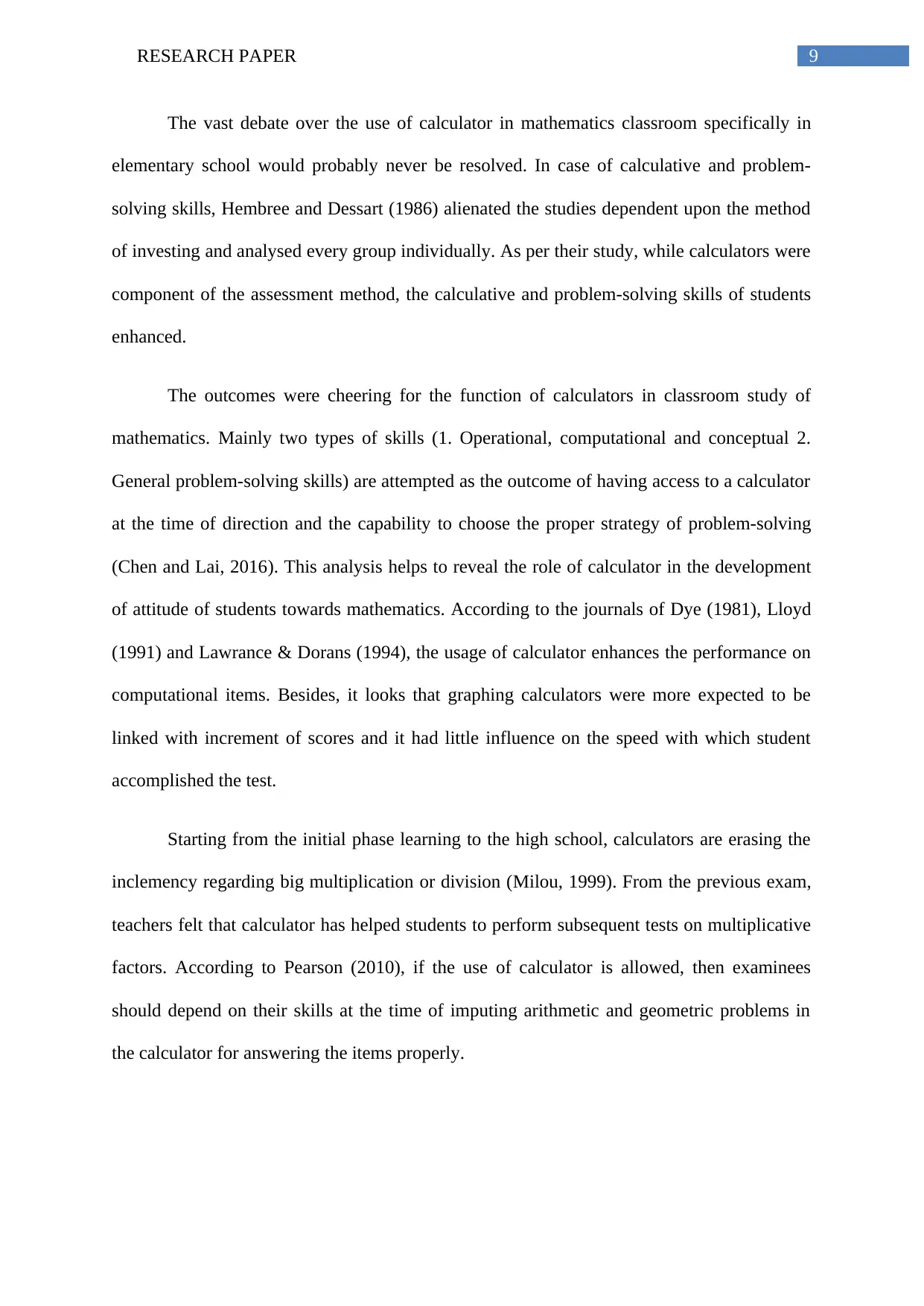
9RESEARCH PAPER
The vast debate over the use of calculator in mathematics classroom specifically in
elementary school would probably never be resolved. In case of calculative and problem-
solving skills, Hembree and Dessart (1986) alienated the studies dependent upon the method
of investing and analysed every group individually. As per their study, while calculators were
component of the assessment method, the calculative and problem-solving skills of students
enhanced.
The outcomes were cheering for the function of calculators in classroom study of
mathematics. Mainly two types of skills (1. Operational, computational and conceptual 2.
General problem-solving skills) are attempted as the outcome of having access to a calculator
at the time of direction and the capability to choose the proper strategy of problem-solving
(Chen and Lai, 2016). This analysis helps to reveal the role of calculator in the development
of attitude of students towards mathematics. According to the journals of Dye (1981), Lloyd
(1991) and Lawrance & Dorans (1994), the usage of calculator enhances the performance on
computational items. Besides, it looks that graphing calculators were more expected to be
linked with increment of scores and it had little influence on the speed with which student
accomplished the test.
Starting from the initial phase learning to the high school, calculators are erasing the
inclemency regarding big multiplication or division (Milou, 1999). From the previous exam,
teachers felt that calculator has helped students to perform subsequent tests on multiplicative
factors. According to Pearson (2010), if the use of calculator is allowed, then examinees
should depend on their skills at the time of imputing arithmetic and geometric problems in
the calculator for answering the items properly.
The vast debate over the use of calculator in mathematics classroom specifically in
elementary school would probably never be resolved. In case of calculative and problem-
solving skills, Hembree and Dessart (1986) alienated the studies dependent upon the method
of investing and analysed every group individually. As per their study, while calculators were
component of the assessment method, the calculative and problem-solving skills of students
enhanced.
The outcomes were cheering for the function of calculators in classroom study of
mathematics. Mainly two types of skills (1. Operational, computational and conceptual 2.
General problem-solving skills) are attempted as the outcome of having access to a calculator
at the time of direction and the capability to choose the proper strategy of problem-solving
(Chen and Lai, 2016). This analysis helps to reveal the role of calculator in the development
of attitude of students towards mathematics. According to the journals of Dye (1981), Lloyd
(1991) and Lawrance & Dorans (1994), the usage of calculator enhances the performance on
computational items. Besides, it looks that graphing calculators were more expected to be
linked with increment of scores and it had little influence on the speed with which student
accomplished the test.
Starting from the initial phase learning to the high school, calculators are erasing the
inclemency regarding big multiplication or division (Milou, 1999). From the previous exam,
teachers felt that calculator has helped students to perform subsequent tests on multiplicative
factors. According to Pearson (2010), if the use of calculator is allowed, then examinees
should depend on their skills at the time of imputing arithmetic and geometric problems in
the calculator for answering the items properly.
Paraphrase This Document
Need a fresh take? Get an instant paraphrase of this document with our AI Paraphraser
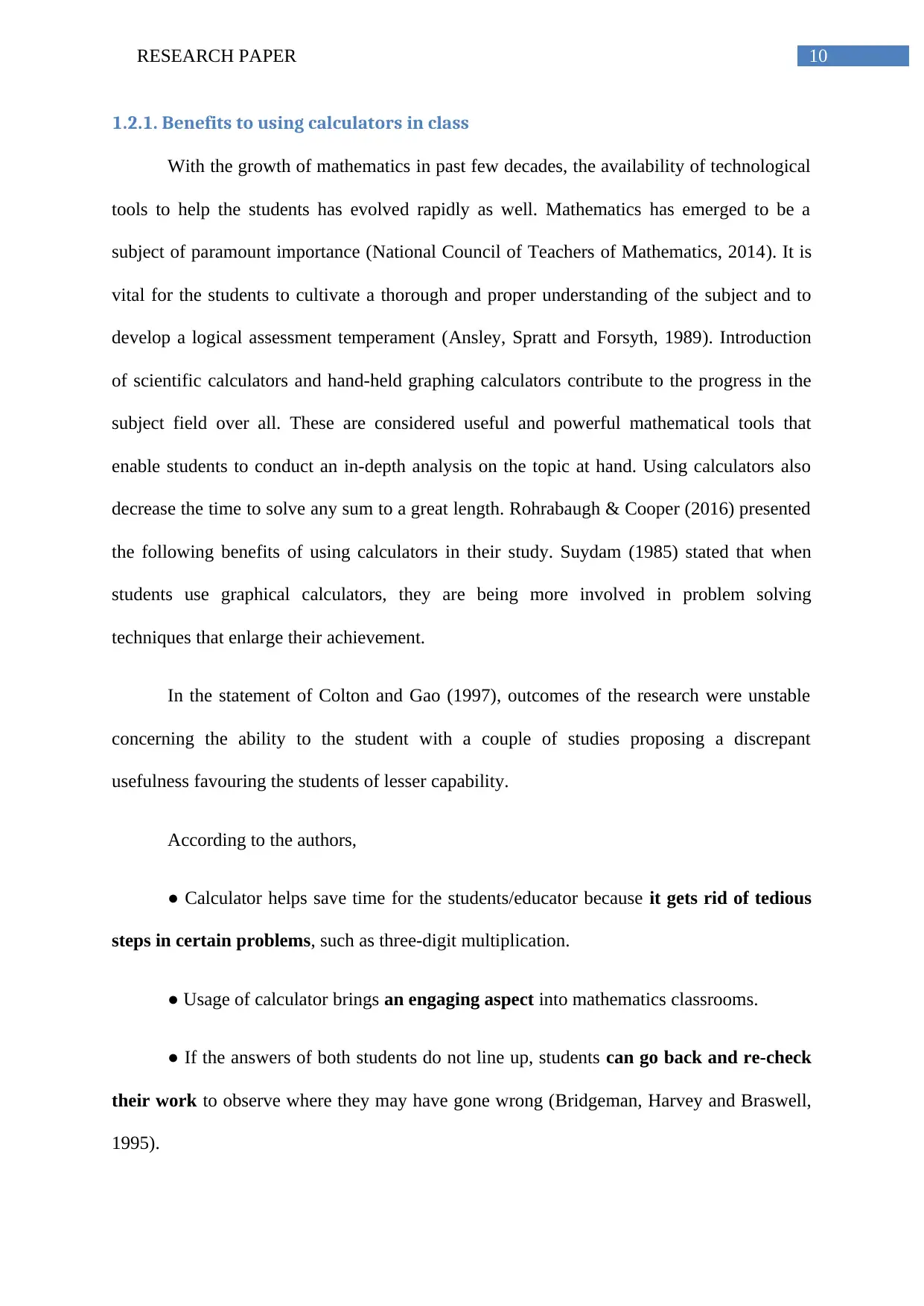
10RESEARCH PAPER
1.2.1. Benefits to using calculators in class
With the growth of mathematics in past few decades, the availability of technological
tools to help the students has evolved rapidly as well. Mathematics has emerged to be a
subject of paramount importance (National Council of Teachers of Mathematics, 2014). It is
vital for the students to cultivate a thorough and proper understanding of the subject and to
develop a logical assessment temperament (Ansley, Spratt and Forsyth, 1989). Introduction
of scientific calculators and hand-held graphing calculators contribute to the progress in the
subject field over all. These are considered useful and powerful mathematical tools that
enable students to conduct an in-depth analysis on the topic at hand. Using calculators also
decrease the time to solve any sum to a great length. Rohrabaugh & Cooper (2016) presented
the following benefits of using calculators in their study. Suydam (1985) stated that when
students use graphical calculators, they are being more involved in problem solving
techniques that enlarge their achievement.
In the statement of Colton and Gao (1997), outcomes of the research were unstable
concerning the ability to the student with a couple of studies proposing a discrepant
usefulness favouring the students of lesser capability.
According to the authors,
● Calculator helps save time for the students/educator because it gets rid of tedious
steps in certain problems, such as three-digit multiplication.
● Usage of calculator brings an engaging aspect into mathematics classrooms.
● If the answers of both students do not line up, students can go back and re-check
their work to observe where they may have gone wrong (Bridgeman, Harvey and Braswell,
1995).
1.2.1. Benefits to using calculators in class
With the growth of mathematics in past few decades, the availability of technological
tools to help the students has evolved rapidly as well. Mathematics has emerged to be a
subject of paramount importance (National Council of Teachers of Mathematics, 2014). It is
vital for the students to cultivate a thorough and proper understanding of the subject and to
develop a logical assessment temperament (Ansley, Spratt and Forsyth, 1989). Introduction
of scientific calculators and hand-held graphing calculators contribute to the progress in the
subject field over all. These are considered useful and powerful mathematical tools that
enable students to conduct an in-depth analysis on the topic at hand. Using calculators also
decrease the time to solve any sum to a great length. Rohrabaugh & Cooper (2016) presented
the following benefits of using calculators in their study. Suydam (1985) stated that when
students use graphical calculators, they are being more involved in problem solving
techniques that enlarge their achievement.
In the statement of Colton and Gao (1997), outcomes of the research were unstable
concerning the ability to the student with a couple of studies proposing a discrepant
usefulness favouring the students of lesser capability.
According to the authors,
● Calculator helps save time for the students/educator because it gets rid of tedious
steps in certain problems, such as three-digit multiplication.
● Usage of calculator brings an engaging aspect into mathematics classrooms.
● If the answers of both students do not line up, students can go back and re-check
their work to observe where they may have gone wrong (Bridgeman, Harvey and Braswell,
1995).
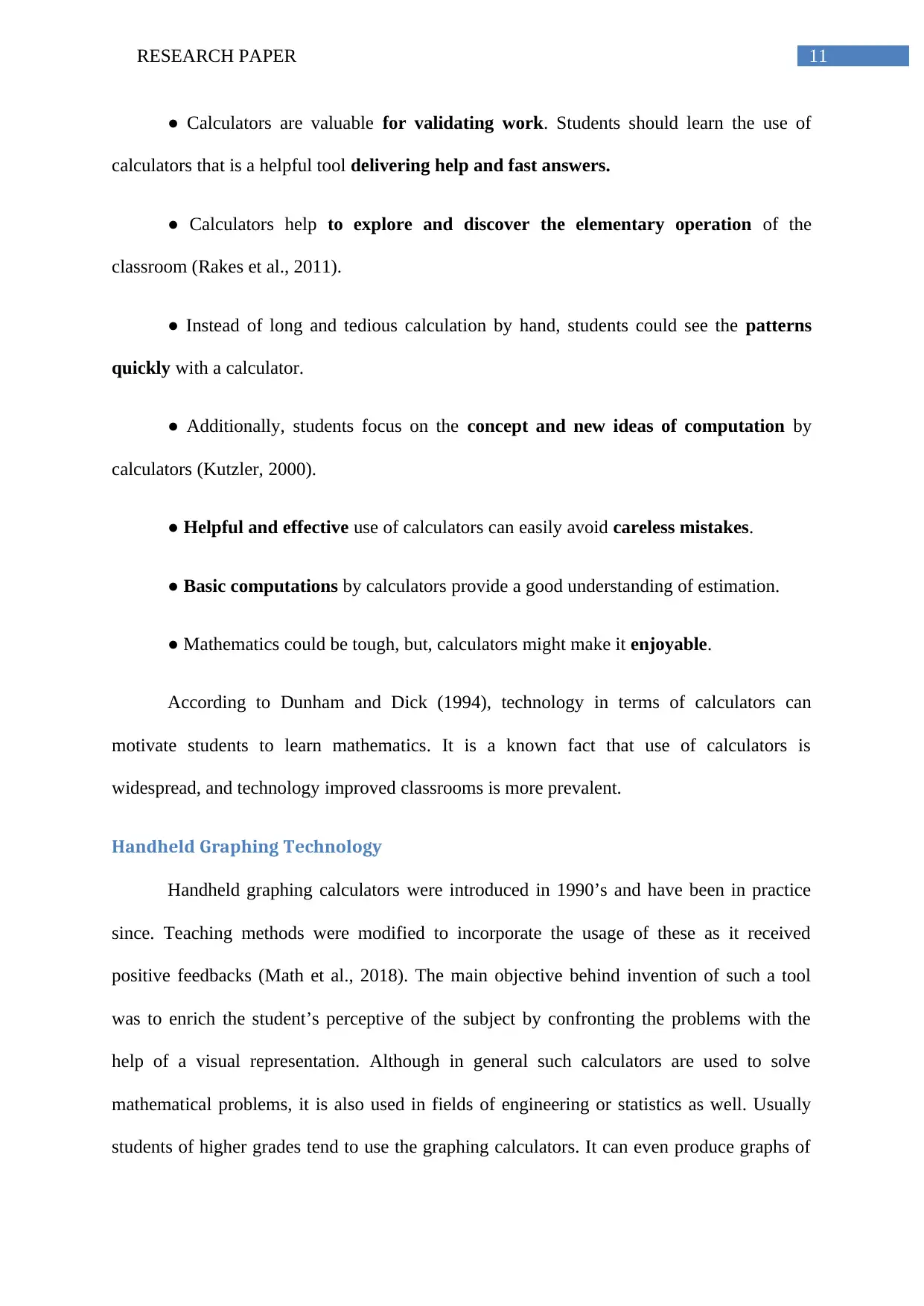
11RESEARCH PAPER
● Calculators are valuable for validating work. Students should learn the use of
calculators that is a helpful tool delivering help and fast answers.
● Calculators help to explore and discover the elementary operation of the
classroom (Rakes et al., 2011).
● Instead of long and tedious calculation by hand, students could see the patterns
quickly with a calculator.
● Additionally, students focus on the concept and new ideas of computation by
calculators (Kutzler, 2000).
● Helpful and effective use of calculators can easily avoid careless mistakes.
● Basic computations by calculators provide a good understanding of estimation.
● Mathematics could be tough, but, calculators might make it enjoyable.
According to Dunham and Dick (1994), technology in terms of calculators can
motivate students to learn mathematics. It is a known fact that use of calculators is
widespread, and technology improved classrooms is more prevalent.
Handheld Graphing Technology
Handheld graphing calculators were introduced in 1990’s and have been in practice
since. Teaching methods were modified to incorporate the usage of these as it received
positive feedbacks (Math et al., 2018). The main objective behind invention of such a tool
was to enrich the student’s perceptive of the subject by confronting the problems with the
help of a visual representation. Although in general such calculators are used to solve
mathematical problems, it is also used in fields of engineering or statistics as well. Usually
students of higher grades tend to use the graphing calculators. It can even produce graphs of
● Calculators are valuable for validating work. Students should learn the use of
calculators that is a helpful tool delivering help and fast answers.
● Calculators help to explore and discover the elementary operation of the
classroom (Rakes et al., 2011).
● Instead of long and tedious calculation by hand, students could see the patterns
quickly with a calculator.
● Additionally, students focus on the concept and new ideas of computation by
calculators (Kutzler, 2000).
● Helpful and effective use of calculators can easily avoid careless mistakes.
● Basic computations by calculators provide a good understanding of estimation.
● Mathematics could be tough, but, calculators might make it enjoyable.
According to Dunham and Dick (1994), technology in terms of calculators can
motivate students to learn mathematics. It is a known fact that use of calculators is
widespread, and technology improved classrooms is more prevalent.
Handheld Graphing Technology
Handheld graphing calculators were introduced in 1990’s and have been in practice
since. Teaching methods were modified to incorporate the usage of these as it received
positive feedbacks (Math et al., 2018). The main objective behind invention of such a tool
was to enrich the student’s perceptive of the subject by confronting the problems with the
help of a visual representation. Although in general such calculators are used to solve
mathematical problems, it is also used in fields of engineering or statistics as well. Usually
students of higher grades tend to use the graphing calculators. It can even produce graphs of
⊘ This is a preview!⊘
Do you want full access?
Subscribe today to unlock all pages.

Trusted by 1+ million students worldwide
1 out of 41
Related Documents
Your All-in-One AI-Powered Toolkit for Academic Success.
+13062052269
info@desklib.com
Available 24*7 on WhatsApp / Email
![[object Object]](/_next/static/media/star-bottom.7253800d.svg)
Unlock your academic potential
Copyright © 2020–2025 A2Z Services. All Rights Reserved. Developed and managed by ZUCOL.





